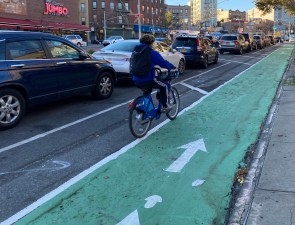SEE NO EVIL? NYPD Inexplicably Removes Bike Injury Data From TrafficStat

The NYPD has mysteriously removed statistics on bike injuries from its online database even as cycling — and cycling injuries from car drivers — are a key side-effect of the COVID-19 pandemic.
During the early days of the crisis back in March, Streetsblog reported on the spike in bike injuries, which have since ebbed and flowed citywide, but have consistently gone up in the Bronx. Our stories were based on numbers updated weekly on the NYPD’s TrafficStat’s page, which features collision and injury statistics broken down by borough and precinct.
But now, the bike numbers are missing, though the number of total collisions, total injuries, and pedestrian injuries are still provided to the public — a troubling omission given that the city’s Vision Zero initiative had a bloody year last year, when 29 cyclists were killed, and hundreds more injured, on the streets of New York City. (It is unclear if the NYPD put the bike injury numbers into the overall injury column, or just eliminated them as a separate statistic.)
“With bike use booming, cycling crashes are a critical barometer for overall traffic safety. Every agency with a hand in Vision Zero should be tracking them closely,” said Bike New York’s Jon Orcutt.

Data on the NYPD’s Traffic Stat portal — which was launched in 2016 to provide information about enforcement and increase public transparency by providing an accessible raw-feed of collision data — also includes easy-to-read year-to-date and 28-day stats compared to the same period of time during the previous year, more detailed breakdowns of when and where each crash took place, and factors that likely led to them. All of that information is still accessible for motor vehicle collisions and pedestrian injuries on the NYPD’s portal, but not for collisions causing injuries to cyclists.
The city does provide data on bike injuries on its Open Data portal of Motor Vehicle Collisions, but it’s does not allow for easy comparison to data from previous weeks, months and years, which allows the public to easily discern trends in road carnage.
The missing NYPD stats come as both DOT Commissioner Polly Trottenberg and Mayor de Blasio have defended the police department as a valued “partner” of Vision Zero, despite multiple recent videos of cops using their bikes as weapons, cops plowing their squad cards into a crowd of protestors back in May, and last summer, when a cop used his squad car to stop a Citi Bike rider who had allegedly run two red lights.
And it also comes less than a month after the advocacy group Bike New York raised concerns about the way data relating to traffic safety and traffic-related deaths are kept and shared with the public, demanding the city reconfigure its Vision Zero View website, which is managed by DOT.
“Provide a clearer picture of traffic safety issues and trends by providing more information about fatal and injury crashes on the city’s Vision Zero View website,” the July 29 letter says. “It could serve a stronger role informing the public, elected officials, media and other constituencies about the city’s traffic safety progress and challenges if it provided additional, easy-to-recognize data points.”
Specifically, the letter says, since DOT Commissioner Polly Trottenberg has said that trucks were involved in a disproportionate number of cyclist and pedestrian fatalities last year, the data should be organized to clearly show that.
“City initiatives like the Green Wave bicycle safety plan spotlighted trucks as a problem in accelerating cyclist deaths in 2019, but this trend is not reflected in any way on Vision Zero View,” the letter says.
Bike New York issued a list of demands to make traffic-related data more accessible:
- Expand data provided to the public on the site to include vehicle types in its crash records — whether an injury or fatal crash involved a truck, a for-hire vehicle, a bus, an SUV or a government-owned vehicle.
- Make data on the site sortable by geography as well as time.
- Create a separate injury/fatality category for people hurt or killed while using small electric vehicles.
- Create a separate injury/fatality category for motorcyclist crashes
Bike New York has also asked for multiple reforms of the NYPD, including getting it out of some traffic management and enforcement roles best left to DOT.
The DOT did not respond to request for comment about updating its data, and a spokeswoman for the NYPD said the agency is “looking into” the missing bike stats.
The NYPD’s outdated record-keeping is well documented. Streetsblog has reported in the past on the NYPD’s poor transparency, including when cops fudge official police reports to blame victims instead of a driver, when cops write up reckless drivers only after a viral video of a motorist blowing through a stop sign and hitting a cyclist, and when they keep vital crash documents under lock and key from public scrutiny.
The NYPD’s press office — officially the Deputy Commissioner for Public Information, which reporters shorthand as “DCPI” — routinely denies media requests for public information, ignores questions and turns down interview requests so that reporters can understand the reasoning behind policy decisions. Few reporters write about the agency’s practices for fear that they will be shut out of even the limited information that the NYPD provides.
The NYPD also issues press credentials, which makes reporters even more reluctant to complain about DCPI’s information shortcomings.




